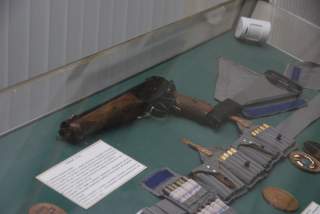FACT: Russian Cosmonauts Carried a Shotgun Into Space
The TP-82 was for shooting bears with both barrels.
For the Soviets, the weapon was a case of “better safe than sorry,” and from 1986, it was a permanent fixture in the portable survival kits of every Soyuz mission.
NASA decommissioned its space shuttles in 2011, so all missions to the ISS now use Russian Soyuz capsules. There’s always a spare Soyuzdocked with the station, in case of an emergency.
Even when carrying international crews, the Soyuz spacecraft continued to have a TP-82 aboard until 2007. The custom-made ammunition has long passed its shelf life, so the survival kit now includes a Russian service sidearm—presumably the high-powered MP-443 or a Makarov PM. The Russian Space Agency doesn’t discuss the TP-82 or its successor.
Astronauts of all nationalities—including Americans—have trained with the TP-82. And still today, before they ride the Soyuz to space, they must complete a Russian survival training course in the Black Sea and the Siberian forest.
The experience includes shooting practice and an introduction to the story of Voskhod 2.
But recently, it seems the Russians are leaving their guns behind. According to space historian James Oberg, who publicized the practice of carrying arms aboard Soyuz flights, Russian crews vote on whether to carry a pistol or not—and they regularly choose not to.
Oberg argued that weapons should not be carried into space at all. “I suggested the presence of the gun, especially in light of recent space team psychological problems, might be an invitation to a future disaster,” he wrote at IEEE Spectrum.
If the Russians wanted to prepare for the worst, Oberg suggested, they could stow the weapon in an external hold so it’s only accessible after landing.
To be sure, in the modern age of GPS and satellite communications, a repeat of the Voskhod 2 stranding is unlikely. But as we saw with Malaysia Airlines Flight 370 last year, big vehicles can still go missing.
In 2008, a Soyuz capsule made a ballistic reentry and landed 250 miles off course. Mission control lost track of them. The crew had to call in their location with a satellite phone from their survival kit. For 30 minutes, the capsule carrying South Korea’s first astronaut was completely off the grid.
Accidents can happen any time. Better hope the next crew is as lucky as Leonov and Belyayev should something go wrong.
This first appeared in WarIsBoring here.

